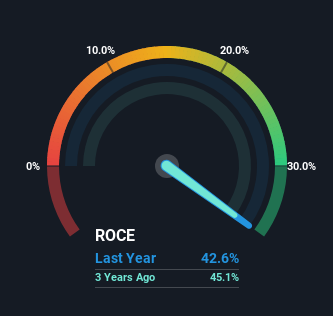- United States
- /
- Interactive Media and Services
- /
- NasdaqGS:TZOO
Why The 43% Return On Capital At Travelzoo (NASDAQ:TZOO) Should Have Your Attention

If you're not sure where to start when looking for the next multi-bagger, there are a few key trends you should keep an eye out for. Ideally, a business will show two trends; firstly a growing return on capital employed (ROCE) and secondly, an increasing amount of capital employed. If you see this, it typically means it's a company with a great business model and plenty of profitable reinvestment opportunities. Speaking of which, we noticed some great changes in Travelzoo's (NASDAQ:TZOO) returns on capital, so let's have a look.
What Is Return On Capital Employed (ROCE)?
For those who don't know, ROCE is a measure of a company's yearly pre-tax profit (its return), relative to the capital employed in the business. The formula for this calculation on Travelzoo is:
Return on Capital Employed = Earnings Before Interest and Tax (EBIT) ÷ (Total Assets - Current Liabilities)
0.43 = US$10m ÷ (US$66m - US$42m) (Based on the trailing twelve months to March 2023).
Thus, Travelzoo has an ROCE of 43%. In absolute terms that's a great return and it's even better than the Interactive Media and Services industry average of 8.3%.
View our latest analysis for Travelzoo

Above you can see how the current ROCE for Travelzoo compares to its prior returns on capital, but there's only so much you can tell from the past. If you're interested, you can view the analysts predictions in our free report on analyst forecasts for the company.
So How Is Travelzoo's ROCE Trending?
Investors would be pleased with what's happening at Travelzoo. Over the last five years, returns on capital employed have risen substantially to 43%. The company is effectively making more money per dollar of capital used, and it's worth noting that the amount of capital has increased too, by 21%. The increasing returns on a growing amount of capital is common amongst multi-baggers and that's why we're impressed.
On a separate but related note, it's important to know that Travelzoo has a current liabilities to total assets ratio of 63%, which we'd consider pretty high. This effectively means that suppliers (or short-term creditors) are funding a large portion of the business, so just be aware that this can introduce some elements of risk. Ideally we'd like to see this reduce as that would mean fewer obligations bearing risks.
Our Take On Travelzoo's ROCE
To sum it up, Travelzoo has proven it can reinvest in the business and generate higher returns on that capital employed, which is terrific. Astute investors may have an opportunity here because the stock has declined 58% in the last five years. So researching this company further and determining whether or not these trends will continue seems justified.
If you want to continue researching Travelzoo, you might be interested to know about the 3 warning signs that our analysis has discovered.
Travelzoo is not the only stock earning high returns. If you'd like to see more, check out our free list of companies earning high returns on equity with solid fundamentals.
Valuation is complex, but we're here to simplify it.
Discover if Travelzoo might be undervalued or overvalued with our detailed analysis, featuring fair value estimates, potential risks, dividends, insider trades, and its financial condition.
Access Free AnalysisHave feedback on this article? Concerned about the content? Get in touch with us directly. Alternatively, email editorial-team (at) simplywallst.com.
This article by Simply Wall St is general in nature. We provide commentary based on historical data and analyst forecasts only using an unbiased methodology and our articles are not intended to be financial advice. It does not constitute a recommendation to buy or sell any stock, and does not take account of your objectives, or your financial situation. We aim to bring you long-term focused analysis driven by fundamental data. Note that our analysis may not factor in the latest price-sensitive company announcements or qualitative material. Simply Wall St has no position in any stocks mentioned.
About NasdaqGS:TZOO
Travelzoo
Operates as an Internet media company that provides travel, entertainment, and local experiences worldwide.
Undervalued with reasonable growth potential.
Similar Companies
Market Insights
Community Narratives



